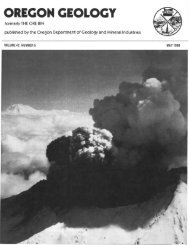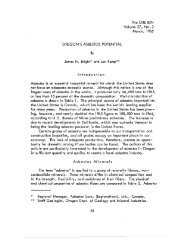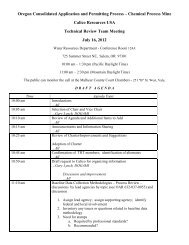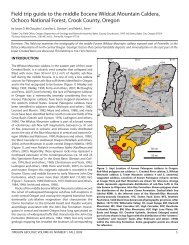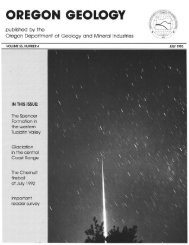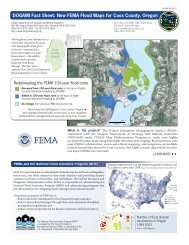Ore Bin / Oregon Geology magazine / journal - Oregon Department ...
Ore Bin / Oregon Geology magazine / journal - Oregon Department ...
Ore Bin / Oregon Geology magazine / journal - Oregon Department ...
- No tags were found...
You also want an ePaper? Increase the reach of your titles
YUMPU automatically turns print PDFs into web optimized ePapers that Google loves.
FACIES (TIME TRANSGRESSIVE)<br />
Elll SHELF<br />
o SLOPE<br />
IZ'J TRENCH<br />
o ABYSSAL PLAIN<br />
OUTER<br />
HIGH<br />
less deformed sediments, and essentially undeformed<br />
shelf deposits cover the slope units with apparent angular<br />
discordance. This model is illustrated in Figure 6.<br />
The modern analog suggests that the Umpqua<br />
Group and Tyee Formation were sequential parts of an<br />
accreting continental margin, with depositional patterns<br />
closely related to structural development.<br />
V.E. ],I<br />
Figure 6. The Umpqua Group may have been deposited<br />
on an accreting continental slope and shelf in a<br />
fashion similar to that proposed by Seely and others<br />
(1974), with whose permission this illustration is<br />
reproduced.<br />
SYNTHESIS<br />
One explanation of the structures in the Sutherlin<br />
area could be that they were formed in a single deformational<br />
event after deposition of the Roseburg sediments<br />
and then uplifted and eroded prior to deposition of the<br />
Lookingglass Formation. However, the change in rock<br />
types going up in the stratigraphic column shows a logical<br />
transition from the thin, rhythmic, turbidite slope<br />
deposits of the Roseburg Formation to the deltaic or<br />
shelf deposits of the nearby Tyee Formation. The large,<br />
northeast-trending folds in the Sutherlin area were forming<br />
while the Roseburg sediments were being deposited<br />
on the continental slope. Decreasing deformation upward<br />
in the section also indicates a transition to a more<br />
stable shelf environment, and the relationship between<br />
stratigraphy and structure suggests that deposition and<br />
structural development occurred contemporaneously.<br />
Currents carrying Roseburg sediments may well<br />
have been controlled by the growing, northeasterlytrending<br />
folds. By the time of deposition of the Tyee<br />
Formation, these structures had become inactive, and<br />
almost all were buried, although a few remaining topographic<br />
highs on the Tyee sea floor locally affected flow<br />
patterns, as near Drain. Turbidity flows originating<br />
near the top of the slope to the south and east would<br />
have been deflected by the developing ridges to flow<br />
down trough axes; as each successive trough was filled,<br />
or where the divide was low, flows would have overtopped<br />
the adjacent downslope ridge and contributed<br />
finer grained and progressively younger sediments to the<br />
next lower trough. This model, like a series of baffles<br />
across a slope, would explain both the Roseburg Formation<br />
current directions and the northward change to<br />
finer grained facies.<br />
The modern continental margin of <strong>Ore</strong>gon and<br />
Washington (Silver, 1971, 1972; Carson and others,<br />
1974; Kulm and Fowler, 1974) is comparable to this<br />
model. Longitudinal ridges and troughs characterize the<br />
present continental slope. Seismic profiles show these<br />
ridges to be anticlinal and commonly bounded by steep<br />
faults; the intervening troughs are filled with younger,<br />
ACKNOWLEDGMENTS<br />
Our thanks to Chris L. Nastrom, who assisted in<br />
drafting, to Ewart M. Baldwin for many discussions of<br />
Umpqua stratigraphy, and to our colleagues for critically<br />
reading the manuscript and patiently listening to<br />
our ideas.<br />
REFERENCES<br />
Baldwin, E.M., 1964, Thrust faulting in the Roseburg area,<br />
<strong>Ore</strong>gon: <strong>Ore</strong>gon <strong>Department</strong> of <strong>Geology</strong> and Mineral Industries,<br />
<strong>Ore</strong> <strong>Bin</strong>, v. 26, no. 10, p. 176-184.<br />
- - - 1965, <strong>Geology</strong> of the south end of the <strong>Ore</strong>gon Coast<br />
Range Tertiary basin: Northwest Science, v. 39, no. 3,<br />
p. 93-103.<br />
- - - 1.974, Eocene stratigraphy of southwestern <strong>Ore</strong>gon:<br />
<strong>Ore</strong>gon <strong>Department</strong> of <strong>Geology</strong> and Mineral Industries<br />
Bulletin 83, 40 p.<br />
- - - 1975, Revision of the Eocene stratigraphy of southwestern<br />
<strong>Ore</strong>gon, in Weaver, D.W., Hornaday, G.R., and<br />
Tipton, A., eds., Paleogene Symposium and selected technical<br />
papers: Annual Meeting, Pacific Sections, AAPG,<br />
SEPM, SEG, Long Beach, Calif., April 1975, p. 49-64.<br />
- - - 1976, <strong>Geology</strong> of <strong>Ore</strong>gon (rev. ed.): Dubuque, la.,<br />
Kendall/Hunt Publishing Co., p. 25.<br />
Baldwin, E.M., and PerUu, R.K., 1980, Paleogene stratigraphy<br />
and structure along the Klamath borderland, <strong>Ore</strong>gon, in<br />
Oles, K.F., Johnson, J.K., Niem, A.R., and Niem, W.A.,<br />
eds., Geologic field trips in western <strong>Ore</strong>gon and southwestern<br />
Washington: <strong>Ore</strong>gon <strong>Department</strong> of <strong>Geology</strong> and Mineral<br />
Industries Bulletin 101, p. 9-31.<br />
Carson, B., Yuan, J., Meyers, P.B., Jr., and Barnard, W.D.,<br />
1974, Initial deep-sea sediment deformation at the base of<br />
the Washington continental slope: a response to subduction:<br />
<strong>Geology</strong>, v. 2, no. 11, p. 561-564.<br />
Diller, J.S., 1898, Roseburg folio, <strong>Ore</strong>gon, folio 49 o/Geologic<br />
atlas of the United States: U.S. Geological Survey.<br />
Girard, W.W., 1962, Stereo net analysis of moderately deformed<br />
sedimentary strata: Eugene, <strong>Ore</strong>g., University of<br />
<strong>Ore</strong>gon master's thesis, 50 p.<br />
Hansen, E., 1971, Strain facies: New York, Springer-Verlag,<br />
207 p.<br />
Kulm, L.D., and Fowler, G.A., 1974, <strong>Ore</strong>gon continental<br />
margin structure and stratigraphy: a test of the imbricate<br />
thrust model, in Burk, C.A., and Drake, c.L., eds., The<br />
(Continued, p. 146)<br />
140<br />
OREGON GEOLOGY. VOL. 42. NO.8. AUGUST 1980





